Birçok WordPress kullanıcısı, bilgisayarlarında yerel bir sunucu kullanarak web siteleri üzerinde çalışmayı tercih eder. Bu, değişiklikleri çevrimiçi olarak kullanıma sunmadan önce web siteniz üzerinde özel olarak çalışmanıza olanak tanır.
Sonunda, çevrimiçi ziyaretçilerin erişimine açmak için web sitenizi canlı bir sunucuya taşımanız gerekecektir. Bu geçiş, web sitenizin canlı sitede düzgün çalışmasını sağlamak için çok önemlidir.
Birçok yerel web sitesi üzerinde çalıştık, bu nedenle içeriği canlı web sitelerine aktarmanın en kolay yolunu öğrenmemiz gerekiyordu.
Bu makalede, WordPress’in yerel bir sunucudan canlı bir siteye nasıl taşınacağına ilişkin adım adım talimatlar vereceğiz.
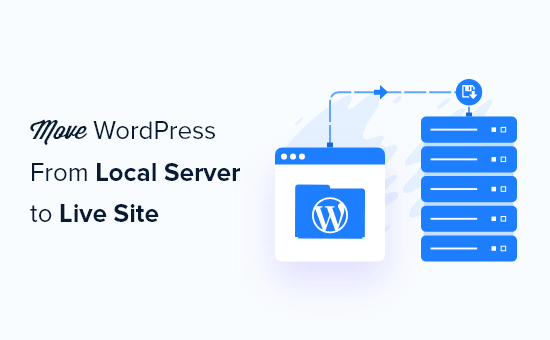
WordPress’i Neden Yerel Sunucudan Canlı Siteye Taşımalısınız?
WordPress blogunuzu yerel bir sunucuda oluşturmak, web sitenizdeki değişiklikleri ziyaretçileri etkilemeden test etmenin güvenli bir yoludur.
Web sitenizi mükemmelleştirmeyi tamamladığınızda, bir sonraki adım yerel sunucunuzdan canlı bir siteye geçmektir.
Sitenizi yerel bir sunucudan canlı bir siteye taşımanın iki yolunu gösterelim.
İlk yöntem bir WordPress geçiş eklentisi kullanır ve yeni başlayanlar için önerilir.
İkinci yöntemde, WordPress’i yerel bir sunucudan canlı bir siteye manuel olarak nasıl taşıyacağınızı göstereceğiz.
Sizin için en uygun olan yöntemi seçebilirsiniz:
WordPress Sitenizi Taşımadan Önce
WordPress’i yerel bir sunucudan canlı bir sunucuya taşımak için birkaç şeye sahip olmanız gerekir.
İlk olarak, bilgisayarınızdaki yerel bir sunucuda (localhost olarak da adlandırılır) çalışan bir WordPress siteniz olduğunu ve buna tam erişiminiz olduğunu varsayıyoruz.
Ardından, bir alan adına ve web barındırma hizmetine sahip olmanız gerekir.
Kötü veya ücretsiz web barındırma sağlayıcılarıyla başlayıp pişman olan yeni başlayanlardan sayısız hikaye duyduk. Deneyimlerimize göre, doğru barındırma sağlayıcısını seçmek herhangi bir web sitesinin başarısı için kritik öneme sahiptir.
Kararınızı kolaylaştırmak için Bluehost kullanmanızı öneririz. Resmi olarak önerilen bir WordPress barındırma şirketidir ve WPBeginner kullanıcılarına özel bir indirim + ücretsiz alan adı ve SSL veriyorlar.
Temel olarak, ayda 1,99 $ gibi düşük bir ücretle başlayabilirsiniz.
Harika bir Bluehost alternatifi istiyorsanız, Hostinger‘a bakabilirsiniz. Ayrıca WPBeginner kullanıcılarına ücretsiz bir alan adı ile özel bir indirim sunuyorlar.
Biraz daha fazla ödemeyi göze alabiliyorsanız, SiteGround‘a göz atın. Ayrıca WPBeginner okuyucuları için özel bir fırsatları var.
Web sitenizi kurmak için yardıma ihtiyacınız varsa, bir web sitesinin nasıl yapılacağına ilişkin adım adım kılavuzumuzu izleyin.
Son olarak, bir FTP programına ihtiyacınız olacak ve yerel sunucu sitenizi canlı siteye yüklemek için FTP’yi nasıl kullanacağınızı bileceksiniz.
Hazır mısınız? WordPress sitenizi taşımaya başlayalım.
Video Eğitimi
Yazılı talimatları tercih ediyorsanız, okumaya devam edin.
Yöntem 1: Bir Geçiş Eklentisi Kullanarak WordPress’i Yerel Sunucudan Canlı Siteye Aktarın (Önerilen)
Bu yöntem daha kolaydır ve yeni başlayanlar için önerilir. WordPress’i localhost’tan canlı bir siteye taşımak için bir WordPress migration eklentisi kullanacağız.
Adım 1: Duplicator Eklentisini Kurun ve Ayarlayın
Öncelikle, yerel sitenize Duplicator eklentisini yüklemeniz ve etkinleştirmeniz gerekir. Daha fazla ayrıntı için, bir WordPress eklentisinin nasıl kurulacağına ilişkin adım adım kılavuzumuza bakın.
Profesyonelİpucu: Duplicator ‘ın güvenli yedeklemeler, bulut depolama, kolay site geri yükleme ve daha fazlasını sunan profesyonel bir sürümü de vardır.
Etkinleştirmenin ardından, Duplicator ” Yedeklemeler sayfasına gitmeniz ve ‘Yeni Oluştur’ düğmesine tıklamanız gerekir.
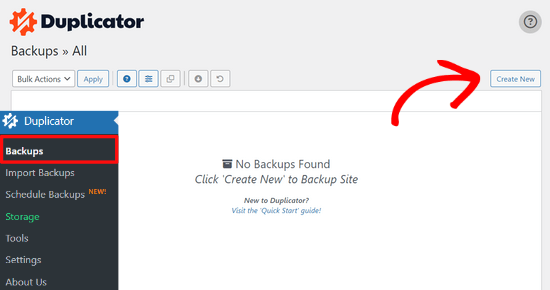
Bu sizi yedeklemenize bir ad verebileceğiniz bir ekrana getirir.
Ardından, ‘İleri’ düğmesine tıklayın.

Duplicator şimdi her şeyin yolunda olup olmadığını görmek için bazı testler yapacaktır.
Tüm öğeler ‘İyi’ olarak işaretlenmişse, ‘Oluştur’ düğmesine tıklayın.

Bu işlem, web sitenizin boyutuna bağlı olarak birkaç dakika sürebilir. İşlem tamamlanana kadar bu sekmeyi açık bırakmalısınız.
Tamamlandığında, ‘Yükleyici’ ve ‘Arşiv’ paketleri için indirme seçenekleri göreceksiniz. Her iki dosyayı da bilgisayarınıza indirmek için ‘Her İki Dosyayı da İndir’ düğmesine tıklamanız gerekir.

‘Arşiv’ dosyası WordPress sitenizin eksiksiz bir kopyasıdır. Tüm WordPress çekirdek dosyalarının yanı sıra resimlerinizi, yüklemelerinizi, temalarınızı, eklentilerinizi ve WordPress veritabanınızın bir yedeğini içerir.
‘Yükleyici’ dosyası, web sitenizi içeren arşiv dosyasını açarak tüm geçiş sürecini otomatikleştirecek bir komut dosyasıdır.
Adım 2: Canlı WordPress Web Siteniz İçin Bir Veritabanı Oluşturun
Yükleyiciyi çalıştırmadan veya WordPress web sitesini localhost’tan hosting sunucunuza yüklemeden önce, yeni canlı web siteniz için bir MySQL veritabanı oluşturmanız gerekir.
Zaten bir MySQL veritabanı oluşturduysanız, bu adımı atlayabilirsiniz.
Bir veritabanı oluşturmak için hosting hesabınızın cPanel kontrol panelini ziyaret etmeniz gerekir. Ardından, ‘Veritabanları’ bölümünü bulun ve ‘MySQL Veritabanı Sihirbazı’ simgesine tıklayın.
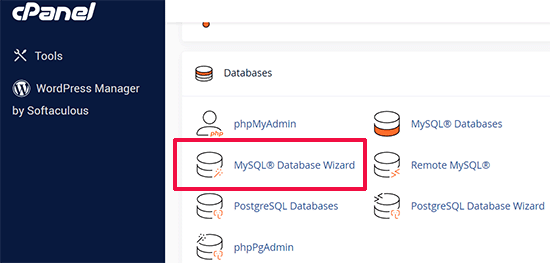
Bir sonraki ekranda, yeni bir veritabanı oluşturmak için bir alan vardır.
Veritabanınız için bir ad girin ve ‘Veritabanı Oluştur’ düğmesine tıklayın.

cPanel şimdi sizin için yeni bir veritabanı oluşturacaktır.
Bundan sonra, yeni kullanıcınız için bir kullanıcı adı ve şifre girmeniz ve ardından ‘Kullanıcı Oluştur’ düğmesine tıklamanız gerekir.
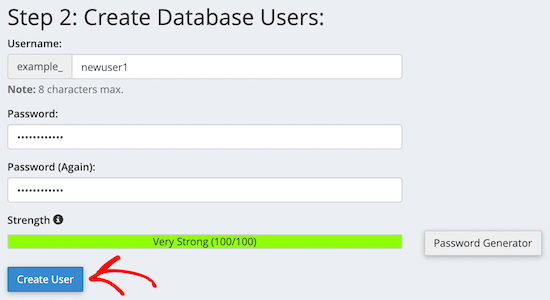
Ardından, yeni oluşturduğunuz kullanıcıyı veritabanına eklemeniz gerekir.
İlk olarak, ‘Tüm Ayrıcalıklar’ onay kutusunu tıklayın.
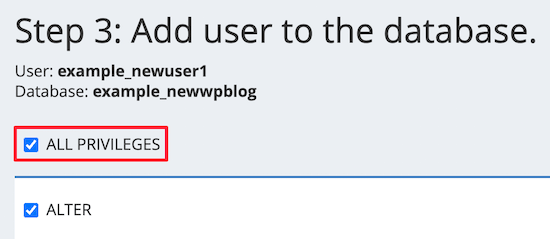
Ardından, aşağı kaydırın ve değişikliklerinizi kaydetmek için ‘Değişiklik Yap’ düğmesine tıklayın.
Veritabanınız artık WordPress sitenizle birlikte kullanılmaya hazırdır. Veritabanı adını, kullanıcı adını ve parolayı not ettiğinizden emin olun. Bu bilgilere bir sonraki adımda ihtiyacınız olacak.
Adım 3: Dosyaları Yerel Sunucudan Canlı WordPress Web Sitesine Yükleyin
Şimdi, arşiv ve yükleyici dosyalarını yerel sitenizden barındırma hesabınıza yüklemeniz gerekir.
İlk olarak, bir FTP istemcisi kullanarak canlı sitenize bağlanın. Bağlandıktan sonra, web sitenizin kök dizininin tamamen boş olduğundan emin olun.
Normalde kök dizin /home/public_html/ klasörüdür.
Bazı WordPress barındırma şirketleri, kaydolduğunuzda WordPress’i otomatik olarak yükler. Eğer orada WordPress dosyalarınız varsa, onları silmeniz gerekir.
Bundan sonra, archive.zip ve installer.php dosyalarını Duplicator’dan boş kök dizininize yükleyebilirsiniz.

Adım 4: Geçiş Komut Dosyasını Çalıştırma
Geçiş dosyalarını yükledikten sonra, tarayıcınızda aşağıdaki URL’yi ziyaret etmeniz gerekir:
http://example.com/installer.php
‘example.com’ yerine kendi alan adınızı yazmayı unutmayın.
Bu, Duplicator geçiş sihirbazını başlatacaktır.
Yükleyici birkaç test çalıştıracak ve komut dosyasını başlatacaktır.
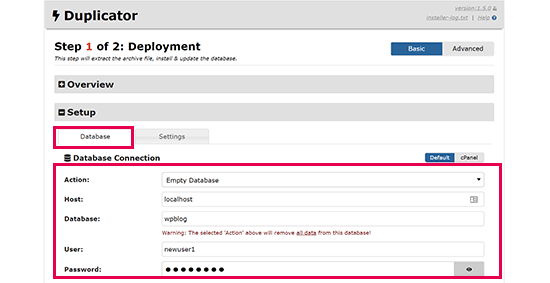
Kurulum bölümü altında, MySQL ana bilgisayarınızı, veritabanı adınızı, kullanıcı adınızı ve şifrenizi girmeniz istenecektir.
Ana bilgisayarınız muhtemelen yerel bir ana bilgisayar olacaktır. Bundan sonra, bir önceki adımda oluşturduğunuz veritabanının ayrıntılarını gireceksiniz.
Ardından, girdiğiniz bilgilerin doğru olduğundan emin olmak için ‘Doğrula’ düğmesine tıklayın.
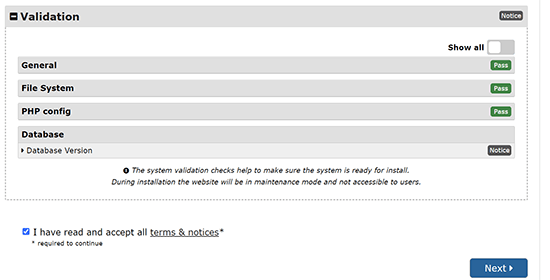
Bundan sonra, devam etmek için ‘İleri’ düğmesine tıklayın.
Duplicator şimdi WordPress veritabanı yedeğinizi arşivden yeni veritabanınıza aktaracaktır.
Ayrıca yerel siteye ve yeni canlı sitenize işaret eden URL’leri de güncelleyecektir.
Artık canlı sitenizin WordPress yönetici alanına girmek için ‘Yönetici Girişi’ düğmesine tıklayabilirsiniz.

Canlı sitenizde oturum açtığınızda, Duplicator kurulum dosyalarını otomatik olarak temizleyecektir.
Hepsi bu kadar. WordPress’i yerel sunucudan canlı sitenize başarıyla taşıdınız.
Yöntem 2: WordPress’i Yerel Sunucudan Canlı Siteye Manuel Olarak Aktarın
Bu yöntemde, WordPress’i yerel sunucudan canlı sitenize manuel olarak nasıl taşıyacağınızı göstereceğiz. İlk yöntem işe yaramazsa veya manuel olarak yapmayı tercih ederseniz faydalı olacaktır.
Adım 1: Yerel WordPress Veritabanını Dışa Aktarın
Yapmanız gereken ilk şey yerel WordPress veritabanınızı dışa aktarmaktır. Bunu yapmak için phpMyAdmin kullanacağız.
Eğer bu konuda bilginiz yoksa, phpMyAdmin kullanarak WordPress veritabanı yönetimi rehberimize göz atmak isteyebilirsiniz.
Basitçe http://localhost/phpmyadmin/ adresine gidin ve WordPress veritabanınıza tıklayın. Ardından, üst menü çubuğundan ‘Dışa Aktar’ düğmesine tıklayın.

‘Dışa aktarma yöntemi:’ seçeneğinde, ‘Hızlı’ veya ‘Özel’i seçebilirsiniz. Özel, veritabanınızı dışa aktarmak için size daha fazla seçenek sağlayacaktır.
Ancak veritabanınızı indirmek için ‘Hızlı’yı seçmenizi ve ardından ‘Git’ düğmesine tıklamanızı öneririz.

Adım 2: WordPress Dosyalarını Canlı Siteye Yükleyin
Şimdi, tüm web sitesi dosyalarınızı canlı siteye taşımamız gerekecek.
Başlamak için FTP istemcinizi açın ve web barındırma hesabınıza bağlanın.
Canlı sitenize bağlandıktan sonra, dosyaları doğru dizine yüklediğinizden emin olun. Örneğin, sitenin ‘yoursite.com’ adresinde barındırılmasını istiyorsanız, tüm dosyaları public_html dizininize yüklemek isteyeceksiniz.
Şimdi yerel WordPress dosyalarınızı seçin ve canlı sunucunuza yükleyin.
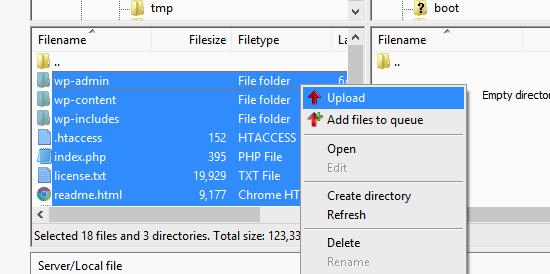
Adım 3: Canlı Sitenizde MySQL Veritabanı Oluşturun
FTP istemciniz WordPress dosyalarınızı yüklerken, veritabanınızı canlı sunucuya aktarmaya başlayabilirsiniz.
Çoğu WordPress barındırma sağlayıcısı, barındırma hesabınızı yönetmek için cPanel sunar, bu nedenle size cPanel kullanarak nasıl veritabanı oluşturacağınızı göstereceğiz.
Öncelikle, cPanel panonuza giriş yapmanız ve ‘Veritabanları’ bölümünde bulunan ‘MySQL Veritabanı Sihirbazı’ simgesine tıklamanız gerekir.

Bir sonraki ekranda yeni bir veritabanı oluşturabilirsiniz.
Veritabanınız için bir ad girmeniz ve ardından ‘Veritabanı Oluştur’a tıklamanız gerekir.

cPanel şimdi sizin için otomatik olarak yeni bir veritabanı oluşturacaktır.
Ardından, yeni kullanıcınız için bir kullanıcı adı ve şifre girmeniz ve ardından ‘Kullanıcı Oluştur’a tıklamanız gerekir.
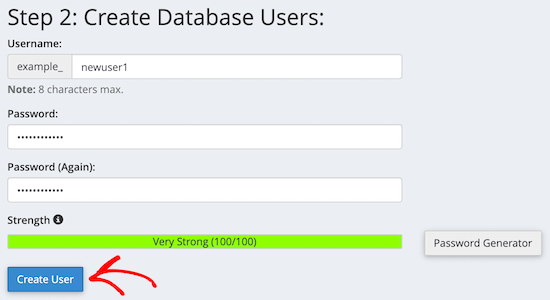
Bundan sonra, yeni oluşturduğunuz kullanıcıyı veritabanına eklemeniz gerekir.
İlk olarak, ‘Tüm Ayrıcalıklar’ onay kutusunu işaretleyin.
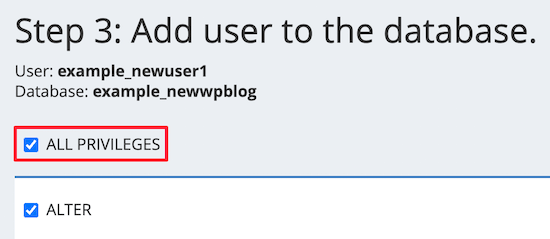
Ardından, aşağı kaydırın ve değişikliklerinizi kaydetmek için ‘Değişiklik Yap’a tıklayın.
Canlı WordPress siteniz için başarıyla yeni bir veritabanı oluşturdunuz.
Adım 4: WordPress Veritabanını Canlı Siteye Aktarın
Süreçteki bir sonraki adım WordPress veritabanınızı içe aktarmaktır.
cPanel panonuza gidin, ‘Veritabanları’ bölümüne ilerleyin ve ‘phpMyAdmin’e tıklayın.
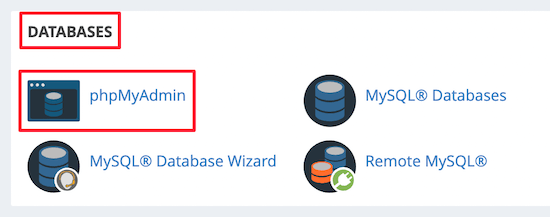
Bu sizi phpMyAdmin’e götürecektir, burada yukarıda oluşturduğunuz veritabanına tıklamak isteyeceksiniz. phpMyAdmin yeni veritabanınızı tablolar olmadan gösterecektir.
Ardından, üst menüdeki ‘İçe Aktar’ sekmesine tıklayın. İçe aktarma sayfasında, ‘Dosya Seç’ düğmesine tıklayın ve ardından ilk adımda kaydettiğiniz yerel sitedeki veritabanı dosyasını seçin.
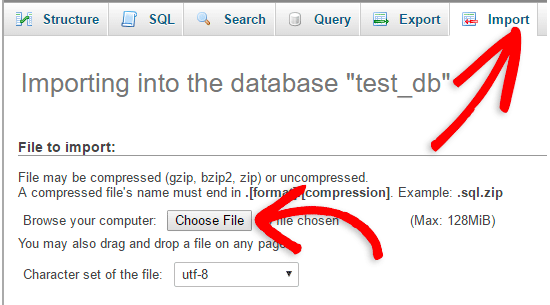
Bundan sonra, sayfanın altındaki ‘Git’ düğmesine tıklayın. Veritabanınız otomatik olarak phpMyadmin’e aktarılacaktır.
Adım 5: Site URL’sini Değiştirin
Şimdi, canlı WordPress sitenize bağlanması için veritabanınızdaki site URL’sini değiştirmeniz gerekir.
phpMyAdmin’de, yukarıda içe aktardığınız veritabanınızdaki wp_options tablosunu arayın.
Veritabanı önekinizi değiştirdiyseniz, wp_options yerine {new_prefix}_options olabilir.
Ardından, wp_options öğesinin yanındaki ‘Gözat’ düğmesine tıklayın. Ya da wp_options tablosundaki alanların bir listesini içeren sayfayı açmak için kenar çubuğundaki bağlantıya tıklayın.
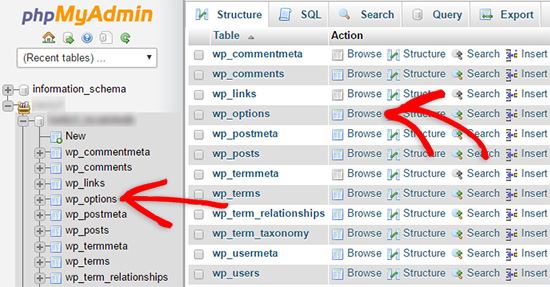
Ardından, options_name sütununda siteurl seçeneğini aramanız gerekir.
Ardından, ‘Düzenle’ simgesine tıklayın.

Bu, alanı düzenleyebileceğiniz bir pencere açar.
option_value giriş kutusunda, yerel yüklemenizin URL’sini göreceksiniz; bu URL http://localhost/test gibi bir şey olacaktır.
Bu alana yeni sitenizin URL’sini girmeniz gerekir, örneğin: https://www.wpbeginner.com.
Ardından, ‘Git’ düğmesine tıklayarak alanı kaydedebilirsiniz.
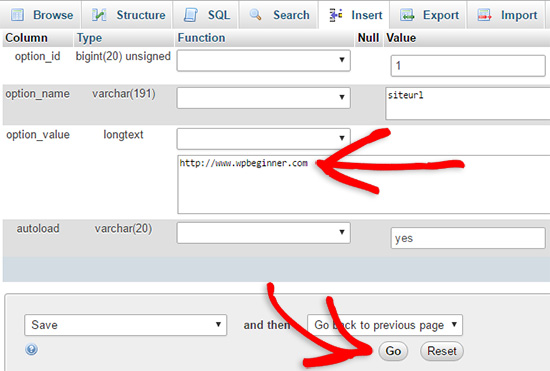
Ardından, ana sayfa seçeneği adı için yukarıdaki adımların aynısını izlemeniz gerekir. wp_options menüsü birkaç sayfa uzunluğunda olabilir. Genellikle, ana sayfa seçeneği ikinci sayfada olacaktır.
Ardından, ana sayfa URL’sini güncelleyin, böylece canlı site URL’nizle aynı olur.
Adım 6: Canlı Sitenizi Kurun
Veritabanını içe aktardığınıza ve içeriğinizi yüklediğinize göre sıra WordPress’i yapılandırmaya geldi.
Şu anda sitenizde‘Veritabanı bağlantısı kurulurken hata oluştu’ hatası görünüyor olmalıdır.
Bunu düzeltmek için, bir FTP istemcisi kullanarak web sitenize bağlanın ve wp-config.php dosyasını açın.
Aşağıdaki kod satırlarını arıyor olacaksınız:
// ** MySQL settings - You can get this info from your web host ** //
/** The name of the database for WordPress */
define( 'DB_NAME', 'database_name_here' );
/** MySQL database username */
define( 'DB_USER', 'username_here' );
/** MySQL database password */
define( 'DB_PASSWORD', 'password_here' );
/** MySQL hostname */
define( 'DB_HOST', 'localhost' );
Daha önce oluşturduğunuz veritabanı adını, kullanıcı adını ve parolayı sağlamanız gerekecektir.
Ardından, wp-config.php dosyasını kaydedin ve WordPress barındırma sunucunuza geri yükleyin.
Şimdi, web sitenizi ziyaret ettiğinizde canlı olması gerekir.
Bundan sonra, WordPress yönetici panelinize giriş yapmanız ve Ayarlar ” Genel bölümüne gitmeniz gerekir. Ardından, hiçbir şeyi değiştirmeden en alta kaydırın ve ‘Değişiklikleri Kaydet’ düğmesine tıklayın.
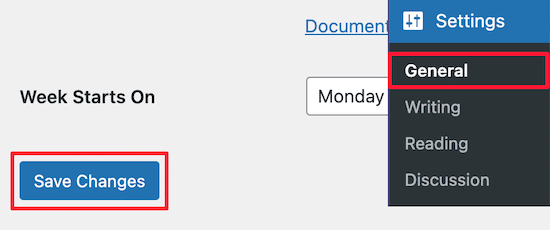
Bu, sitenizin URL’sinin olması gereken başka bir yerde düzeltilmesini sağlayacaktır.
Bunu yaptıktan sonra, Ayarlar ” Kalıcı Bağlantılar’a gidin, ardından aşağı kaydırın ve tüm gönderi bağlantılarının düzgün çalıştığından emin olmak için ‘Değişiklikleri Kaydet’e tıklayın.

Adım 7: Yolları Güncelleyerek Görüntüleri ve Bozuk Bağlantıları Düzeltin
Bir WordPress sitesini bir etki alanından diğerine veya yerel bir sunucudan canlı bir siteye taşıdığınızda, kırık bağlantılar ve eksik görüntülerle karşılaşırsınız.
URL’leri güncellemek için size iki yol göstereceğiz. Sizin için en uygun olanı seçebilirsiniz.
1. Search & Replace Everything Eklentisini Kullanarak URL’leri Güncelleyin (Önerilen)
Bunu düzeltmenin en güvenli yolu Search & Replace Everything kullanmaktır. Karmaşık veritabanı sorguları yazmadan web sitenizde toplu güncelleme görevlerini kolayca gerçekleştirmenizi sağlayan güçlü bir WordPress eklentisidir.
İlk olarak, Search & Replace Everything eklentisini yüklemeniz ve etkinleştirmeniz gerekir.
Etkinleştirmeden sonra Araçlar ” WP Search & Replace sayfasına gidin.
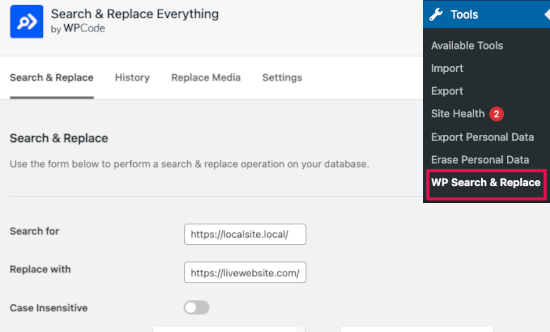
Buradan, yerel site URL’nizi ‘Ara’ alanına ve canlı site URL’nizi ‘Şununla değiştir’ alanına girmeniz gerekir.
Biraz kaydırın ve tabloların altındaki ‘Tümünü Seç’ seçeneğine tıklayın. Bu, eklentinin veritabanındaki her yerde eski URL’yi aramasını sağlar.

Şimdi devam etmek için ‘Arama ve Değiştirmeyi Önizle’ düğmesine tıklayın.
Eklenti, veritabanınızda eski URL’nin tüm örneklerini arayacak ve ardından sonuçları önizleyecektir.
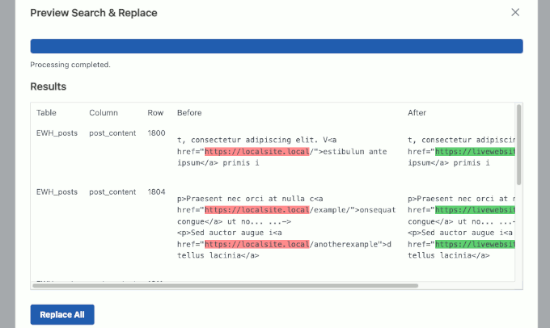
Her şey iyi görünüyorsa, değişiklikleri kaydetmek için ‘Tümünü Değiştir’e tıklayın.
Yaptığınız değişiklikler hakkında bir uyarı göreceksiniz. Devam etmek için ‘Evet’e tıklayın.
Eklenti şimdi veritabanını güncelleyecek ve yerel URL’leri mevcut web sitenizin URL’si ile değiştirecektir.
2. URL’leri Manuel Olarak Güncelleme (Gelişmiş)
URL’leri güncellemenin bir başka yolu da aşağıdaki SQL sorgusunu kullanmaktır:
UPDATE wp_posts SET post_content = REPLACE(post_content, 'localhost/test/', 'www.yourlivesite.com/');
Basitçe phpMyAdmin‘e gidin, veritabanınıza tıklayın ve ardından üst menüden ‘SQL’e tıklayın ve yukarıdaki sorguyu ekleyin.
Yerel siteniz ve canlı site URL’leri olarak değiştirdiğinizden emin olun ve ‘Git’ düğmesine tıklayın.
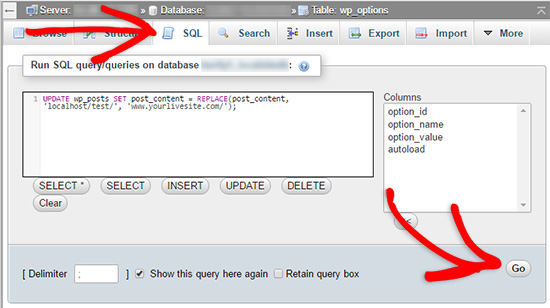
İşte bu kadar. Artık WordPress’i yerel sunucunuzdan canlı bir siteye başarıyla geçirdiniz.
Umarım canlı web siteniz sorunsuz bir şekilde çalışır. Herhangi bir hata fark ederseniz, sorun giderme konusunda yardım almak için yaygın WordPress hataları kılavuzumuza göz atabilirsiniz.
Umarız bu makale WordPress’i yerel bir sunucudan canlı bir siteye taşımanıza yardımcı olmuştur. Ayrıca canlı bir siteyi yerel bir sunucuya taşıma kılavuzumuzu görmek veya pratik WordPress taşıma adımları için nihai web sitesi taşıma kontrol listesine bakmak isteyebilirsiniz.
If you liked this article, then please subscribe to our YouTube Channel for WordPress video tutorials. You can also find us on Twitter and Facebook.





Christian
In step 6, wpbeginner support said, need to update these lines in wp-config.php file for an answer of comment (In Nov 2, 2017 at 12:34 am). Here are lines.
define(‘WP_HOME’,’http://example.com’);
define(‘WP_SITEURL’,’http://example.com’);
My question is, After which line should i need to updates these lines in wp-config.php file?
Here is wp-config.php file without comments.
<?php
define('DB_NAME', 'db');
define('DB_USER', 'user');
define('DB_PASSWORD', 'pass');
define('DB_HOST', 'localhost');
define('DB_CHARSET', 'utf8');
define('DB_COLLATE', '');
define('AUTH_KEY', 'put your unique phrase here');
define('SECURE_AUTH_KEY', 'put your unique phrase here');
define('LOGGED_IN_KEY', 'put your unique phrase here');
define('NONCE_KEY', 'put your unique phrase here');
define('AUTH_SALT', 'put your unique phrase here');
define('SECURE_AUTH_SALT', 'put your unique phrase here');
define('LOGGED_IN_SALT', 'put your unique phrase here');
define('NONCE_SALT', 'put your unique phrase here');
$table_prefix = 'wp_';
define('WP_DEBUG', false);
if ( !defined('ABSPATH') )
define('ABSPATH', dirname(__FILE__) . '/');
require_once(ABSPATH . 'wp-settings.php');
WPBeginner Support
Hi Christian,
You can add them any where before the comment line that says:
/* That’s all, stop editing! Happy blogging. */
To be more precise, you can add these lines after:
define('WP_DEBUG', false)1-click Use in WordPress
Admin
Ian Billingham
Hi there.
Would somebody be able to tell me if this ‘how to’ would overwrite an existing established website? I’m guessing it would.
WPBeginner Support
Hi Ian,
Yes, it will overwrite an existing established website.
Admin
Ravishankar
You are awesome!!! Thank you so much, this was super helpful!
Kate
Hi
Thanks for this informative post. I followed all the instructions carefully and when I tried to see if the site was live at step 6, it came up with the same page that it was had originally. It says ‘Index of/’ as the heading and then has 2 options below (with details of date modified etc). The 2 options are cgi-bin which brings up a 403 error and wordpress which goes to a blank page. Any ideas on what I might have done wrong? I’m very new to this so might have got something confused!
Thanks
Ahmed
Thank you very much, this is very useful
Kritika
Nice and helpful. Thanks
Muhammad Azhar
Hi
i am trying to upload my localhost word press site to live.
I am stuck at where it said “error database connection” i edit the wp-config file and now the only white screen appearing on my web site. I am confused what to do next? “Next, you need to login to your WordPress admin panel and go to Settings » General. be.” I have to install word press at my hosting to perform this step. Please guide.
CK Cheung
Hi,
Many thanks for the instruction. I would like to ask is it possible that I just copy the exported database and upload to the FTP site?
Then I can keep the local host for the future upgrade and testing?
If yes, in future which file I should upload to the ftp and make it live??
Many thanks.
kathy
Hi, I wonder if you can help. I’ve got all the way to editing the config file and uploading i would now appear to be at a sticking point – any ideas on the below? Everything has gone fine to this point. I’ve amended the name, user and password as advised. Would really appreciate any pointers. Thanks
i would now appear to be at a sticking point – any ideas on the below? Everything has gone fine to this point. I’ve amended the name, user and password as advised. Would really appreciate any pointers. Thanks
Server Error in ‘/’ Application.
Runtime Error
Description: An application error occurred on the server. The current custom error settings for this application prevent the details of the application error from being viewed remotely (for security reasons). It could, however, be viewed by browsers running on the local server machine.
Amelia
Hi There. I just want to thank you for such an informative site you are running. I feel like you guys literally held my hand the whole way through, and every glitch I had, you had an article about how to fix it.
I’m happy to say my site is now up and running, while I still have to do a few finishing touches though. Just a great big thank you, I could not have done it without following your website step by step.
Nick
I am having issues with step 6, mainly the part where it says “Next, you need to login to your WordPress admin panel and go to Settings » General. Without changing anything, scroll to the bottom and click the Save Changes button. This will ensure that the site URL is corrected anywhere else that it needs to be.
After that go to Settings » Permalink and click Save Changes to ensure that all post links are working fine”. I cannot go into the settings because I cannot login, I have gotten to the login page but it won’t let me login and I cannot create an account because the link is not connected. How would I get around this problem.
WPBeginner Support
Hi Nick,
You can update the URLs in wp-config.php file as well. Connect to your live website using an FTP client and then add these two lines:
define('WP_HOME','http://example.com'); define('WP_SITEURL','http://example.com');1-click Use in WordPress
Don’t forget to replace example.com with your own URL.
Admin
Nisa
Thank you very much its was very helpful, I was moving WP files from one server to another.
But I cannot compete the 6th step latter part, I can type the Admin username and password, so the site shows I am logged in as the admin from right hand side corner up, but I cannot access the admin panel
I get the error message : “Sorry, you are not allowed to access this page.”
Judit
Hello,
I took ages to set up my website locally, and now I am ready to move it to a live site. However, when I go to I get an error message:
#1045 – Access denied for user ‘xxx'(my username)@’localhost’ (using password: YES)
I’m pretty sure my username and password are correct and yet I cannot log in or change my password.
Please help – I’m afraid that I invested so much time into setting up WP and now I cannot move it to a live site because of this issue.
WPBeginner Support
Hi Judit,
You will need to edit the phpmyadmin’s configuration file:
c:\wamp\apps\phpmyadmin4.1.14\phpmyadmin.conf
Try root for username and leave password field blank. Set ‘AllowNoPassword’ to true. Save your changes and restart WAMPSERVER
Admin
TH
Hi. I moved my site from my local host wamp to my hosting service.
I did all the steps 1-7 but am facing the following problems:
(I had deleted all my plugins to ensure no conflicts)
– when I login as admin, it shows me the login page instead of the homepage and the admin dashboard.
– header menu bar tabs are working OK except for the HOME tab. When I click on HOME it takes me to localhost. Other tabs take me to the right pages.
– Top bar menu tabs (Favorites, Notifications, Logout) are not working. When I click on Favorites it shows: domainname/login/?redirect_to=http%3A%2F%2domainname%2Fdashboard%2Fprojects%2F#favorites and still shows the login page.
– when I click on logout, it shows domainname/login/domainname/wp-login.php?action=logout&_wpnonce=942fbc8980
– when click on > domainname>dashboard it goes to : domainname/login/?redirect_to=http%3A%2F%2Fdomainname%2Fwp-admin%2F and still shows login page
1. What are the problems with the setup? How do I fix them?
2. Should I delete all the WP files and DB on the live server and try again?
Please help.
Thanks.
TH
WPBeginner Support
Hi,
You may want to follow the steps in our WordPress troubleshooting guide. It will help you figure out what’s causing the issue and how to fix it.
Admin
Tara Giltner
Hi,
I followed these directions, they were great. Thank you. My problem is that I still have an error establishing database. I realize it’s probably because the old website is still on the public_html files as well. Is it ok to delete them?
WPBeginner Support
Hi Tara,
Make sure you download the files as backup on your computer before deleting them.
Admin
Jheel
Kindly revert soon.
Jheel
i followed all the steps mentioned above. the website is blank. and i cant even log in my wordpress website i created offline. after doing all the steps when i try to see if the site is live. i get PAGE NOT FOUND & the page contains the home page without bimage & captions. Please tell me what am i suppose to do?
Klaas Cornelis
I Get the “Forbidden: PHP engine is disable” error after completing this steps, I recon i’ve done something wrong. Anyone has an idea of where the fault can be located?
Jolie King
Hello,
I will like to ask if it possible to upload my wordpress website files by zipping all the folders & files, using the upload button in the cpanel to upload it, and then unzipping it after the upload.
Has anyone tried this? Are there any problems encountered after doing this??
Thanks.
Jim Thorne
Jolie, yes…I Zipped my entire WordPress folder and uploaded it using cPanel and then decompressed it into the public_html folder. It worked fantastic.
alan
wow. i better do it again since this look so difficutl
Amirreza
Very useful. Thanks!
Abneer
Hi,
I successfully moved my website from localhost to live site (with a few exceptions). But i had to work on my localhost also so i used update options method given on Codex . I am able to use my admin panel on localhost and only the frontpage. if i click on any other page on the website i get the wamp configuration page. How can i resolve this issue?
Please help me soon!
Thankyou!
Vince
I could really use anyones help desperately; I spent 2 weeks putting a site together and now I can’t get MAMP to work!!!
I had everything working, built the site then had a power outage. Hadn’t used my computer over the weekend and when I came back had the MySQL Error #2002 in the browser window. None of the other windows had content in them as well.
I’ve tried even going back in my Time Machine and still can’t get it to work. When I start MAMP the Apache Server starts but the MySQL Server doesn’t. I even tried things like restarting Apache and MySQL in Terminal and clearing the cache, but still nothing. And I’ve tried fiddling with the preferences in MAMP.
I’ve used MAMP before, a few years ago without any issues or problems. Loved it!!! Worked Great!!!
I’m using Sierra 10.12.6. I first installed MAMP 4.1.1 then when I started having problems I tried to upgrade to 4.2 to see if that help, but no. Had a few problems at first, but did get it to work.
I have another computer running El Capitan and the MySQL Server just doesn’t start on that either. I thought maybe it was the version of PHP that runs on MacOS, so I ran an upgrade and still nothing!
I’m really despise because the site has a scheduled live date, and the customer will freak if it’s not up and running, not to mention my employer!!! Any help would be greatly appreciated!!!
Cheers, Vince
WPBeginner Support
Hey Vince,
It is a common issue with MAMP and you’ll find various solutions online that have worked for other users. The most common solution is to delete the log files located in MAMP/db/mysql directory and then restarting MAMP.
Admin
Sarah
Hello my web page is still showing blank after enabling WP-DEBUG to true
Chamini
I did every step and now my site is in live.
But now I have another two issues,
1.all of my styles and images were not in the site
2.When I’m trying to go to other menus I can’t go to them.It shows 500 Internal Server Error.
Please help me to get out from here
Chris
Hi, did you fix this? I’m having the same problem.
I’ve deleted .htaccess and created a new one. I’ve changed permalink structure to %postname%, I’ve used the velvet blues AND SQL links update but still get this error. Not sure where else to go from here…
Maiyo
I recommend changing the WP_DEBUG option to true value in the wp_option doc to see what errors are occurring if you have a blank page or HTTP 500 error message
Jordan
I followed the steps exactly, but when I got to step 6 when I loaded the website, it worked, but all the information and templates and pages I designed were not there.
I was still able to access my localhost website and I tried to use WP Migrate to transfer all the information across, but that didn’t work. So I followed this guys instructions:
Now my localhost website does not work anymore…..
I guess I’m just going to have to redesign the entire website online now.
WPBeginner Support
Hi Jordan,
Please review your database settings. Go to phpMyAdmin to compare your live site database with your local server database.
Admin
Nou Kanvanny
Hello sir my appearance dnt see tool option, pleas help me
thank you
Craig
I recieve this error when trying to import my database:
Error
SQL query:
—
— Database: `wordpress_test`
—
CREATE DATABASE IF NOT EXISTS `wordpress_test` DEFAULT CHARACTER SET utf8 COLLATE utf8_general_ci;
MySQL said: Documentation
#1044 – Access denied for user ‘craigpar4_root’@’%’ to database ‘wordpress_test’
Can someone help me?
Thanks
Liv
This seems to have worked, but only on my local computer. The new WordPress website shows up at the proper domain on my computer. But when trying the same domain on my phone or a different computer, the old website still pops up.
Patricia LaCroix
Did you clear the cache on those other computers? Sometimes, that’s the issue.
Susan Keogh
I’m failing at Step 1! I type in the phpmyadmin address – and nothing is found. What am I doing wrong?
MrPET
Dear,
everything you said worked for me. Had some problem with admin back end page but after deleted .htaccess file and refresh, everything is just fine.
Jason
Dear WPBeginner,
I had followed all your steps correctly but now my wp-admin page is gone! it says 404!
Even tho the wp-admin folder exsisted.
Please help
WPBeginner Support
Hi Jason,
Try refreshing your WordPress permalinks structure. Since you can’t access admin area, you will need to do it via FTP. Connect to your website, and locate .htaccess file. Download it to your computer as backup, and then delete the file from your server. Visit the homepage of your website and WordPress will regenerate the .htaccess file for you. You can then try to login.
Admin
Jason
Yeah, you are too late 19 days to respond to my comment…
I had moved my site with pain… that means re-install and copy and pasting stuff from old one to the new one T-T
WPBeginner Support
Hi Jason,
Our apologies for the late reply. We try to respond to comments and questions in a timely manner but due to large number of comments we can sometimes miss legit questions.
Tiernan
Many thanks for the very helpful advice that has really simplified an otherwise tricky process
Kariena
Hi, very useful thanks.
Just a question, when adding content to a plugin on my localhost wp-admin, do I need to import my database again to my live site in order to update changes. (I mean do I need to import my database every time I make changes ?)
Laura
Hello, thanks for the post, it’s super helpful!!! Quick question – should I create my XML sitemap and submit it to Google / Webmaster tools while my site is still on my local server or should I upload it to the live server first?
WPBeginner Support
Hey Laura,
Your would need to upload your site to a live server first.
Admin
jenny
Thank you this is very usefull thank you again
Kim Sofo
I am having problems with this. I think its step 2. Can you please clarify where I should be uploading the wordpress files from? Are they installed as part of WAMP? So thats where I would find them? Or are they elsewhere? Thanks
Rohit Gogoi
Can you make a video on this please…Some steps are not clear. Like the second step. I didn’t got it. Please help me out.
WPBeginner Support
Hey Rohit,
We will try to add a video soon. Meanwhile, you will need an FTP client for the step 2. Once you are connected to your website, you will then upload local WordPress files from your computer to the live website.
Admin
Collins
Thanks a lot, the write up was helpful. However after exporting my database and importing it to my live server, i lost some database files. Is there any possible means or tools to retrieve them back? Help please
Rizki Suciana
Very useful.. thank you so much!
Ari
Thanks for the outstanding post. It really was comprehensive and allowed me to successfully transfer my site from local to server!
The only part I had to be ‘externally resourceful’ on was the save settings when exporting my SQL database, to make sure it didn’t create a new one (as you correctly speculated, my ISP only allowed for one database).
Ritul
Is it safe to transfer website from localhost to live server??because I want to know whether I should start with live hostingOrLocal Server for making my blog??
Kirsty
Please helpppppp
When I changed my url from the .dev to .com it’s telling me 404 site not found and I can’t event get back to wordpress to fix it. :'(
WPBeginner Support
Please see our guide on how to fix 404 error in WordPress.
Admin
Tony Clarkson
Hello, I’m having trouble importing the localhost db content in to the new database, I’ve double checked the step-by-step and as far as I can see I’m doing the right thing but I’m getting this error when importing:
Error
SQL query:
—
— Database: `push_db`
—
— ——————————————————–
—
— Table structure for table `wp_commentmeta`
—
CREATE TABLE `wp_commentmeta` (
`meta_id` BIGINT( 20 ) UNSIGNED NOT NULL ,
`comment_id` BIGINT( 20 ) UNSIGNED NOT NULL DEFAULT ‘0’,
`meta_key` VARCHAR( 255 ) COLLATE utf8mb4_unicode_520_ci DEFAULT NULL ,
`meta_value` LONGTEXT COLLATE utf8mb4_unicode_520_ci
) ENGINE = INNODB DEFAULT CHARSET = utf8mb4 COLLATE = utf8mb4_unicode_520_ci;
MySQL said: Documentation
#1273 – Unknown collation: ‘utf8mb4_unicode_520_ci’
When I choose the custom option for exporting the local database, I’m assuming all the other settings remain as default, just change to ‘Save output to a file’
What do you think it could be?
Tony
Tony Clarkson
I got past this bit, the version of MySQL on the local site was newer then the server, however, I’ve come to a halt again at step 6. When I browse the site I just get an Http Error 500. Not sure where to start…
Peter Singh
Hi Tony,
I had a similar problem with another site that I had to get live a while ago. I found that the root of the http 500 error was due to insufficient memory allowance in the php.ini file. I know you cant really get in and change that about on a webserver. I found a little trick by defining it within the wp-config/php file. Just stick this in at the top line.
define( ‘wp_max_memory_limit’ ‘256m’ )
and bob’s your uncle.
Dawn
I tried this and there was no change… Still either a 500 error or a blank page. :'(
WPBeginner Support
Hey Dawn,
Please try these WordPress troubleshooting steps to figure out what’s causing the issue.
Victor
Hey, Tony. How do you managed the problem with MySQL version? I’m getting the same error here and have no idea where to start. Could you clarify this for me?
Victor
Hello, I managed to bypass this issue, but now I’m with a different one.
All my pages, including WP admin (login, dashboard etc) are showing in plain HTLM. As if there no layout and styling. What could it be?
goutam majumder
Thanks so much for this detail steps. You saved my day.
God bless you
Che Devert
Such a wonderful write up. Thanks.
H Finn
This tutorial is excellent. As long as you follow the steps, and you have no problems on your own end – it works like a charm.
Thank you for this post.
Mohanraj
Hello Friends,
I have done one WordPress project in Local Server. I need to upload wp project in a Sub-Directory. Tell me the Procedures
Stephanie
Hi
I transfered a local website to my live server and followed all steps. I just updated all the URL found with localhost:888 by my final URL
All pages are fine except one where I lost one slider and one table on the page.
Anyone to help me please?
Alex Hammerschmied
I also appreciate this post very much!
It becomes handy everytime i need to walk threw a migration…
Thx for that! And keep on the good work!
Best,
Alex
WPBeginner Support
Hey Alex,
We are glad you find it helpful Don’t forget to join us on Twitter for more WordPress tips and tutorials.
Don’t forget to join us on Twitter for more WordPress tips and tutorials.
Admin